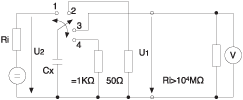What is dielectric absorption?
7 September 2005
Passive Components
Information from Avnet Kopp
A capacitor that has been charged for a long time and then been completely discharged again has a small voltage on its terminal wires, within seconds or minutes. This effect is known as 'dielectric absorption'.
This phenomenon has a particularly unfavourable effect in sample and hold applications in which charges are to be stored for comparison/measuring purposes. The recharging comes from polarisation processes in the insulating material and is largely independent of the capacitance of the capacitor and the thickness of the dielectric.
Measuring of dielectric absorption
The standard MIL-C-19978 describes the measuring method of the dielectric absorption. Referring to the circuit diagram in Figure 1:
Figure 1. Test circuit
The capacitor Cx is charged for 15 minutes on a reference DC voltage, for example, up to the rated DC voltage of the capacitor. The initial current surge may not exceed 50 mA. At the end of the charging time the capacitor is separated from the charging source and discharged over a resistance of 50 Ω. The discharging resistance is removed from the capacitor after 10 seconds. The 'regained voltage' is measured after a period of 15 minutes with a high-Ω (input resistance greater than 10 000 MΩ) millivoltmeter.
The dielectric absorption DA can then be calculated according to the following formula:
DA = U1/U2 x 100%.
Where: DA = dielectric absorption; U1 = regained voltage; U2 = charging voltage.
Typical values of some dielectrics at a temperature of 23°C are: polypropylene, 0,05 to 0,10; polyester, 0,20 to 0,25; mixed dielectric, 0,12 to 0,18; ceramic (X7R), 0,60 to 1,00; ceramic (Z5U), 2,00 to 2,50.
Further reading:
Vibration-resistant axial capacitors
RS South Africa
Passive Components
TDK Corporation has unveiled the B41699 and B41799 series of ultra-compact aluminium electrolytic capacitors, engineered to withstand operating temperatures of up to 140°C.
Read more...
Capacitors for demanding industrial applications
Passive Components
TDK Corporation has announced its X1 capacitors of the EPCOS B3291xH/J4 series for power line filtering of electromagnetic interferences in demanding automotive and industrial applications with a rated AC voltage of up to 480 V.
Read more...
Wide frequency range inductors
RS South Africa
Passive Components
TDK Corporation has expanded its ADL4524VL series
(4,5 x 2,4 x 2,6 mm – L x W x H) of wire-wound inductors for automotive power-over-coax.
Read more...
Cutting-edge hybrid capacitors
Avnet Silica
Passive Components
Panasonic Industry recently announced the launch of the ZVU Series Hybrid Capacitors, a cutting-edge solution tailored to meet the escalating demands of advanced electronic systems.
Read more...
Low-profile tantalum chip capacitors
Electrocomp
Passive Components
These general-purpose tantalum capacitors from Kyocera AVX are available in multiple case sizes with low profile options.
Read more...
Coupled inductor for high-performance applications
Passive Components
This coil with MnZn core is characterised by its high permeability and extremely low RDC values, which achieves excellent power density and very high efficiency.
Read more...
Power inductors
iCorp Technologies
Passive Components
he HTF-MP series is more suitable for complex multiphase power supply applications in design, effectively meeting the needs of ultra-thin and high-power devices.
Read more...
SMT power inductors
Future Electronics
Passive Components
The Würth Elektronik WE-MXGI SMT power inductors are the latest addition to Würth Elektronik’s moulded power inductor series, engineered for high-frequency power applications.
Read more...
Large capacitance MLCCs at 100 V
RS South Africa
Passive Components
TDK Corporation has expanded its CGA series for automotive multilayer ceramic capacitors to 10 µF at 100 V in 3225 size.
Read more...
Film and mica capacitors
Actum
Passive Components
By utilising various polymer dielectrics plastics, Exxelia film and mica capacitors meet most technical requirements and serve all functions from standard filtering to specialised applications.
Read more...


